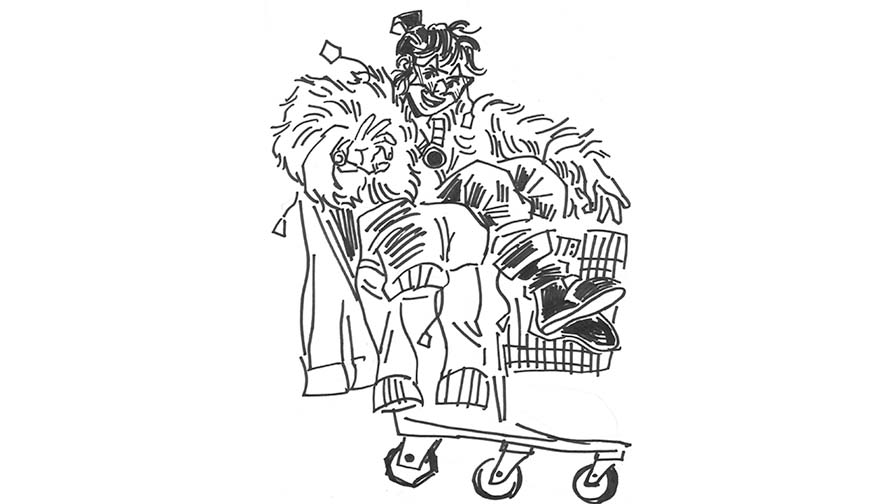Beyond fast fashion: Fanshawe's push for sustainable clothing
 CREDIT: DYLAN CHARETTE
CREDIT: DYLAN CHARETTEAwareness of how the industry can change this landscape has affected many colleges that teach fashion design, including Fanshawe.
How much clothes do you buy during the year? According to CBC Marketplace, Canadians purchase 70 new articles of clothing on average per year (2018). But fast fashion is affecting this number, due to its increased production and release of new styles. Instead of the traditional two seasons (Autumn/Winter and Spring/Summer) where new collections are presented, fast fashion sees 52 micro-seasons yearly.
Buying in fast fashion stores makes shopping accessible for those who crave constant change. And of course, the pieces are cheaper than traditional stores. At the same time, the impact of tonnes of clothes dumped on the environment has become a concern and has mobilized customers, companies, and institutions.
For Fanshawe College professor of fashion marketing and management, Deb Trotechaud, fast fashion is profitable but unviable.
“If we want to stay in business, then we need to speed things up, right? It’s unsustainable, this will not last. It can’t. It just absolutely cannot last,” said Trotechaud.
To produce clothes, the textile industry uses 98 million tonnes of fabric per year with chemicals to finish fibres, fertilizers to grow cotton and oil to synthesize fibres.
“A lot of things are made of oil,” explained Trotechaud. “Like, there’s an oil component to our clothing. And then the burning of unsold garments. At the end of a season, to eliminate the discount markets of their clothing, they’ll be burnt, or they’ll be sent to third world countries, which then goes to landfill there. We need to seriously step back and really look at what’s going on here.”
Awareness of how the industry can change this landscape has affected many colleges that teach fashion design, including Fanshawe. The discussion about the issue even went beyond the classroom. One of the activities students partake in at Fanshawe is to open a pop-up shop to sell second-hand items. Students hand-select goods from Goodwill Industries, and resell them at an affordable price. The money raised goes towards a scholarship for students.
Besides the selling of clothing, the program also works to promote mental health and body positivity.
“For almost two years we have been in the pandemic, and you know, people have been struggling with body issues and stuff like that. This year we decided that we wanted everyone to feel love, everyone to feel good about themselves,” said fashion marketing and management student, Camara Fletcher.
The pop-up store will be open Nov. 22 - Nov. 26. A physical store will be set up at Fanshawe, in the Siskind Gallery, and online at livechic.myshopify.com
Shopping second-hand
Since his teen years in Brazil, 48-year-old Fanshawe student Marcelo Zaharur has been in the habit of buying things in second-hand stores. For him, the decision to buy used clothing goes beyond the lower price.
beyond the lower price. “For sure, saving money is an important aspect, however, the idea of reuse for me is the most important,” said Zaharur. “I believe that things are not totally disposable; it is only a point of view that is useless for someone, but for another person, it could be useful.”
Zaharur buys more than just clothes second-hand.
“The sensation of discovering and imagining how much history that item brings is amazing. It’s a general sensation of ‘treasure hunting,’” he said.
Fletcher, on the other hand, is new to second-hand purchases.
“I buy thrift and it’s fun, you get stuff that’s like, unique,” she said. “And it’s like the sense that you’ve given the clothes a longer life….I just find like, more and more people are going through then it’s inexpensive and you’re saving the environment because to make one t-shirt, you’re saving so much water. It’s gonna be a stepping stone.”
According to Trotechaud, shopping second-hand is becoming ‘cool’ and some people understand that.
“When you go shopping to the stores, everything’s the ….it’s like, boring, and to be really individualized I think it’s great to be able to go out and vintage shop or whatever, right? To find those pieces that are you and you know, no one else is going to have them,” she said.
Just in London- Middlesex, there are more than 20 thrift stores where you can purchase or exchange goods for other items.

















